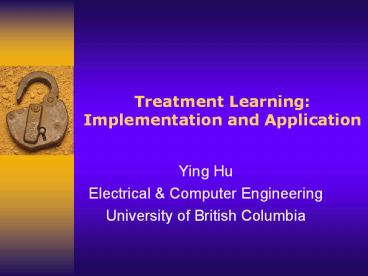Treatment Learning: Implementation and Application PowerPoint PPT Presentation
Title: Treatment Learning: Implementation and Application
1
Treatment LearningImplementation and Application
- Ying Hu
- Electrical Computer Engineering
- University of British Columbia
2
Outline
- An example
- Background Review
- TAR2 Treatment Learner
- TARZAN Tim Menzies
- TAR2 Ying Hu Tim Menzies
- TAR3 improved tar2
- TAR3 Ying Hu
- Evaluation of treatment learning
- Application of Treatment Learning
- Conclusion
3
First Impression
- Boston Housing Dataset
- (506 examples, 4 classes)
4
Review Background
- What is KDD ?
- KDD Knowledge Discovery in Database fayyad96
- Data mining one step in KDD process
- Machine learning learning algorithms
- Common data mining tasks
- Classification
- Decision tree induction (C4.5) quinlan86
- Nearest neighbors cover67
- Neural networks rosenblatt62
- Naive Bayes classifier duda73
- Association rule mining
- APRIORI algorithm agrawal93
- Variants of APRIORI
5
Treatment Learning Definition
- Input classified dataset
- Assume classes are ordered
- Output Rxconjunction of attribute-value pairs
- Size of Rx of pairs in the Rx
- confidence(Rx w.r.t Class) P(ClassRx)
- Goal to find Rx that have different level of
confidence across classes - Evaluate Rx lift
- Visualization form of output
6
Motivation Narrow Funnel Effect
- When is enough learning enough?
- Attributes lt 50, accuracy decrease 3-5
shavlik91 - 1-level decision tree is comparable to C4
Holte93 - Data engineering ignoring 81 features result in
2 increase of accuracy kohavi97 - Scheduling random sampling outperforms complete
search (depth-first) crawford94 - Narrow funnel effect
- Control variables vs. derived variables
- Treatment learning finding funnel variables
7
TAR2 The Algorithm
- Search attribute utility estimation
- Estimation heuristic Confidence1
- Search depth-first search
- Search space confidence1 gt threshold
- Discretization equal width interval binning
- Reporting Rx
- Lift(Rx) gt threshold
- Software package and online distribution
8
The Pilot Case Study
- Requirement optimization
- Goal optimal set of mitigations in a cost
effective manner
Risks
Cost
relates
Requirements
incur
reduce
achieve
Mitigations
Benefit
- Iterative learning cycle
9
The Pilot Study (continue)
- Cost-benefit distribution (30/99 mitigations)
10
Problem of TAR2
- Runtime vs. Rx size
- To generate Rx of size r
- To generate Rx from size 1..N
11
TAR3 the improvement
- Random sampling
- Key idea
- Confidence1 distribution probability
distribution - sample Rx from confidence1 distribution
- Steps
- Place item (ai) in increasing order according to
confidence1 value - Compute CDF of each ai
- Sample a uniform value u in 0..1
- The sample is the least ai whose CDFgtu
- Repeat till we get a Rx of given size
12
Comparison of Efficiency
13
Comparison of Results
- 10 UCI domains, identical best Rx
- Final Rx TAR219, TAR320
14
External Evaluation
C4.5 Naive Bayes
- FSS framework
All attributes (10 UCI datasets)
Feature subset selector TAR2less
15
The Results
- Number of attributes
- Accuracy using C4.5
- (avg decrease 0.9)
- Accuracy using Naïve Bayes
(Avg increase 0.8 )
16
Compare to other FSS methods
- of attribute selected (C4.5 )
- of attribute selected (Naive Bayes)
- 17/20, fewest attributes selected
- Another evidence for funnels
17
Applications of Treatment Learning
- Downloading site http//www.ece.ubc.ca/yingh/
- Collaborators JPL, WV, Portland, Miami
- Application examples
- pair programming vs. conventional programming
- identify software matrix that are superior error
indicators - identify attributes that make FSMs easy to test
- find the best software inspection policy for a
particular software development organization - Other applications
- 1 journal, 4 conference, 6 workshop papers
18
Main Contributions
- New learning approach
- A novel mining algorithm
- Algorithm optimization
- Complete package and online distribution
- Narrow funnel effect
- Treatment learner as FSS
- Application on various research domains

